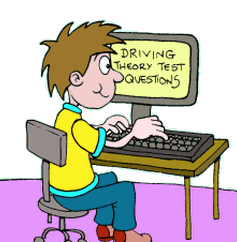How to learn UK road signs
Learning UK road signs is something that will unfortunately require you to
take the time to study them all. Many signs turn up in the theory test so
you do need to take the time to do this. But of course the most important
reason is that you will encounter many road signs whilst driving and knowing
what they mean and being able to take the appropriate action is key to being
a safe driver.
There are some general rules that it is worth remembering when studying the
different road signs.
There are two clues to a warning sign. The first is that they are generally
triangular in shape; the second is that many of them have a thick red border
line around them (although not all of them). Therefore if you see a sign
that's triangular with a red border, and it contains a snowflake, then think
of warnings related to snow and you should be able to come up with "risk of
ice".
Road signs that give you information of some sort are rectangular, for
instance a sign telling you that there are traffic cameras in operation.
When it comes to orders and telling you not to do something, then you will
usually see a sign with a red circle on them.
For instance, a red bordered circle with a speed inside, say 40, tells you
that you cannot go faster than 40, in other words that 40 is the maximum
speed in mph that is permitted.
In addition to learning what all the road signs mean, remember that there
are also the road markings, and it is essential that you learn and
understand what all of these mean in order to be a safe driver. In addition
questions on these form part of the bank of driving theory test questions
too.
Related Articles...
The automatic transmission explained
Whilst the automatic transmission system is very clever, you still need to have some control over it, and this is where the selector lever comes into play, which is in the place that you would have...
The automatic car explained
In most cases, you will learn to drive with a car that has gears in the United Kingdom.
However there are people who prefer to learn in an automatic car, and there are various driving schools...
Your steering system
When it comes to driving the car, it is safe to say that the steering wheel is clearly an essential part! If you can't steer your vehicle, then you clearly cannot drive it.
There are two...
More on Motorway Driving
Signs that let you know there is a motorway ahead are rectangular, and they have a green background. This shows that they are information signs on a primary road.
The part with the reference...
Watching others whilst on the road
You can't rely on other road users not to do something wrong. Whilst most articles on this site tend to focus on cars, there are other and particularly vulnerable road uesrs out there.
These...
How to deal with bus lanes
If you see a bus lane then you will see a range of different attitudes from drivers. Mainly there will be frustration that they are stuck in a huge queue and there is a perfectly good lane that is...
Some common engine faults
It is beyond the scope of the articles here to go into detail about how the engine works and what the various parts of it are. For the theory test you won't need to know a great detail about the...
Your vehicle's age is important
The age of your car is important for several reasons.
The main reason is that if your car is under three years old, there are four documents that you must be in possession of in relation to...
Ways to drive in a greener way
There are several methods that you can employ to ensure that you drive in a green way. The advantages of this are that you consume less fuel pro rata so it is good for your bank balance too, and...
What signs with a percentage mean
When you are driving in some places, the roads will be up and down in terms of gradient, which refers to how the height of the road changes as you move along it, just like on a hill.
When you...
Back to home page of driving theory test questions

